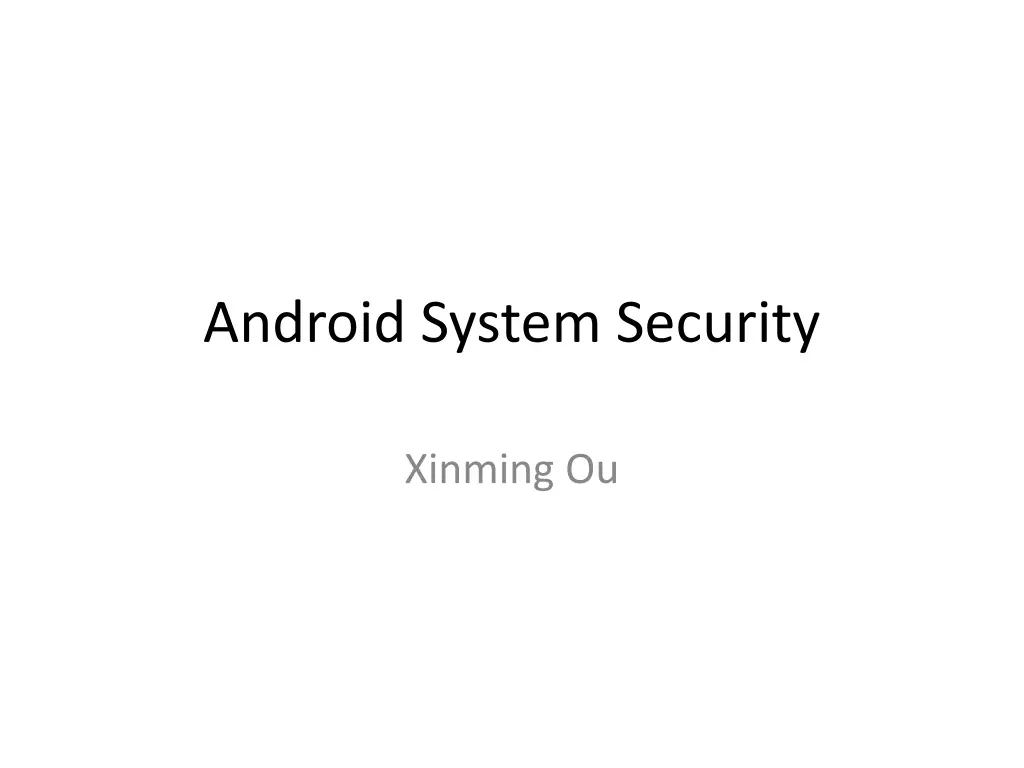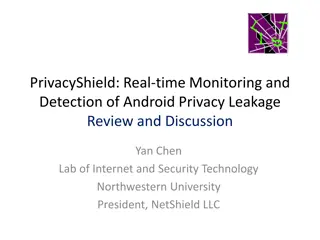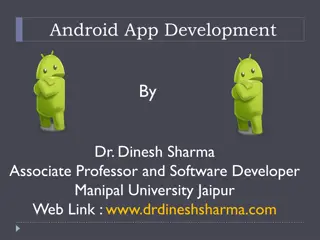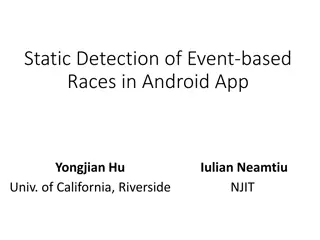
Understanding Android Security: Components, Middleware, and Considerations
Delve into the intricacies of Android security, exploring its system basics, application components, sandbox protection, and critical security considerations. Learn how Android's framework operates, isolates apps within sandboxes, and addresses crucial security goals to safeguard user data and prevent malicious access.
Download Presentation

Please find below an Image/Link to download the presentation.
The content on the website is provided AS IS for your information and personal use only. It may not be sold, licensed, or shared on other websites without obtaining consent from the author. If you encounter any issues during the download, it is possible that the publisher has removed the file from their server.
You are allowed to download the files provided on this website for personal or commercial use, subject to the condition that they are used lawfully. All files are the property of their respective owners.
The content on the website is provided AS IS for your information and personal use only. It may not be sold, licensed, or shared on other websites without obtaining consent from the author.
E N D
Presentation Transcript
Android System Security Xinming Ou
Android System Basics An open-source operating system for mobile devices (AOSP, led by Google) Consists of a base operating system (Linux), an application middleware, and a Java SDK. Available since 2007; first Android phone debut in 2008. Currently the most popular smart-phone platform
Android System Overview App App App Application Middleware Linux OS Hardware
Security Considerations A smart phone is mostly a single-user system The security goal is primarily to protect the user and his/her data The security goal also includes that critical functions of the phone shall not be hampered The apps a phone runs are from manufacturers and app stores The origin of the apps could be untrustworthy apps could be vulnerable or outright malicious
Basic Protection Android Sandbox Each application runs as a user process in the Linux OS with a unique user ID At install time, Android gives each package a distinct Linux user ID Two apps can run under the same user ID if they are signed by the same key This creates a sandbox for each app, so that Linux isolates applications from each other and from the system. An app cannot directly access resources owned by another app if they have different user ids.
However Apps need to communicate with each other and the system A restaurant recommender app may need to launch a map app to show a restaurant s location on map An email app may need to launch a PDF viewer to open an attachment A messenger app may need to receive text messages sent to the phone
Android App Components Each Android app contains one or more components of the following types: Activity: A GUI screen Service: background processing Broadcast Receiver: receives messages from other component Content Provider: store and share data
An Example Source: Understanding Android Security, Enck, et al., IEEE Security & Privacy, 09
Inter-Component Communication (ICC) Source: Understanding Android Security, Enck, et al., IEEE Security & Privacy, 09
Security Protection for ICC An ICC interface is protected in two ways: A private component cannot be accessed outside of the app A component can be protected by permissions A permission is a label defined by the system or app developer to protect an Android component
Android Permission Protection Source: Understanding Android Security, Enck, et al., IEEE Security & Privacy, 09
Policy Specification Each Android app package contains a manifest file that defines all the components in the app, and the permissions needed to access each component The manifest file also contains a list of permissions the app requests from the system and/or user
Difficulty in Understanding Policy Policy can be changed dynamically at runtime, in the app s code A message can be sent requiring a specific permission to receive it at runtime A runtime permission check can be performed to access a component s public method
Difficulty in Understanding Apps Behaviors An app, when given a set of permissions, may misuse them to harm other apps and the user. It is not trivial to understand how an app will use the given permissions
How Android app works Cellular network, Internet, GPS, etc. Event System event Event Input Android System Find the handler User Send intent or Call some callback method Component C Component A Component B App B App A
How Android app works Cellular network, Internet, GPS, etc. Android System Find the target Intent i Intent i Intent i Component C Component A Component B App B App A
A Motivating Example: Sensitive-SMS App DataGrabber Activity Leaker Activity onCreate(Bundle ){ Intent i2 = getIntent(); String s2 = i2.getStringExtra( key ); SmsManager sms = SmsManager.getDefault(); sms.sendTextMessage( , s2, ); } onCreate(Bundle ){ String s1 = getSensitiveData(); Intent i1 = new Intent(); i1.setClass( , Leaker.class); i1.putExtra( key , s1); startActivity(i1); } 4 5 2 App 3 Intent p2 Intent p1 Android System Model Environment of Leaker Environment of DataGrabber 1
Problem 1: Data Leakage source sink Collect sensitive data d Comp X.1 Send Intent with d Comp X.2 ICC sink ICC Data leak ICC Comp X.3 Another App App X
Problem 2: Data Injection Injecting ill-crafted intent Receive Intent source sink Send Intent Comp Y.1 Network I/O Comp Y.2 App Y






















